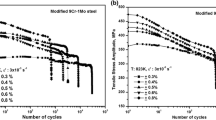Abstract
Very high cycle fatigue (VHCF) tests were carried out to find the fatigue characteristics of a super-long life range by using a cantilever type rotational bending fatigue test machine on three kinds of specimens in bearing steel which were quenched and tempered in air (A: non-shot peened and B: shot peened after heat treatment) and under vacuum environment(C: non-shot peened) in this study. S-N curves obtained from the VHCF tests of the B and C specimens tend to come down again in the super-long life (109 cycles) range due to fish-eye type cracking, while most of the A and B specimens were fractured by surface defects such as scratches and slip lines. This duplex S-N behavior of bearing steel has to be reviewed by the change of the fracture modes.
Similar content being viewed by others
References
T. Sakai, M. Takeda, K. Shiozawa, Y. Ochi, M. Nakajima, T. Nakamura and N. Oguam, Experimental reconfirmation of characteristic S-N property for high cabon chromium bearing steel in wide life region in rotating bending, J. Soc. Mat. Sci., Japan, 49 (2000) 779–785.
K. Shiozawa, Y. Morii and S. Nishino, Subsurface crack initiation and propagation mechanism under the super-long fatigue regime for high speed tool steel (JIS SKH51) by fracture surface topographic analysis” JSME International Journal Series A, 49(1) (2006) 1–10.
Yuji. Nakasone and Hiroaki. Hara, FEM simulation of growth of fish-eye cracks in the very high cycle fatigue of a high strength steel SUJ2 Pro. of 3rd Int. Conf. on Very High Cycle Fatigue (VHCF-3) (2004), 40–47.
T. Sakai, Crack initiation mechanism of bearing steel in high cycle fatigue, Fracture of Nano and Engineering Material and Structure, (2006), 1129–1130.
Q. Y. Wang, Y. Berard, A. Dubarre, G. Baudry, S. Rathery and C. Bathias, Giga cycle fatigue of ferrous alloys, Fatigue Fract. Engng. Mater. Struc. 22 (1999) 667–672.
Y. Murakami, T. Nomoto and T. Ueda, Factors influencing the mechanism of superlong fatigue in steel, Fatigue Fract. Engng. Mater. Struct., 22(1999), 581–590.
S. Nishijima and K. Kanazawa, Stepwise S-N curve and fish-eye failure in giga cycle fatigue, Fatigue Fract. Engng. Mater. Struct., 22(1999), 601–607.
Q. Y. Wang, C. Bathias, N. Kawagoishi and Q. Chen, Effect of inclusion on subsurface crack initiation and giga cycle fatigue strength” Int. J. of Fatigue, 24(2002), 1269–1274.
Tatsuo Sakai, Importance of standardization for fatigue testing and fatigue data analysis in very high cycle regime, Experimental Analysis of Nano and Engineering Material and Structure, (2007), 243–244.
Q. Y. Wang, H. Zhang, M. R. Sriraman and S. X. Li, Very long life fatigue behavior of bearing steel AISI 52100 Key Engineering Materials 297–300 (2005) 1846–1851.
Murakami, Takada and Toriyama, Super-long life tension-compression fatigue properties of quenched and tempered 0.46% carbon steel, Int. J. Fatigue 16,9(1998),.661–667.
Jong-Gyu Lee and Jung-Kyu Kim, Influence of residual stress due to shot peening on fatigue strength and life, KSME International Journal (A), 21–9(1997), 1498–1506.
Chang-Min Suh, Byung-Won Hwang and Murakami, Characteristic of fatigue crack initiation and fatigue strength of nitride 1Cr-1Mo-0.25V turbine rotor steels, KSME International Journal, 16(8) (2002) 1109–1116.
Israel Marines-Garcia, Paul C. Paris, Hiroshi Tada and Claude Bathias, Fatigue crack growth from small to long cracks in VHCF with surface initiations, International Journal of Fatigue 29(2007), 2072–2078.
Author information
Authors and Affiliations
Corresponding author
Additional information
This paper was recommended for publication in revised form by Associate Editor Youngseog Lee
Chang-Min Suh received his B.S. and M.S. degrees in mechanical engineering from Busan Na-tional University in 1964 and 1968, respectively, and received his Ph.D. degree from the University of Tokyo in 1981. He now is a professor at Kyungpook National University. He has served as the Head of the Department of Mechanical Engineering at Kyungpook National University, a Visiting Professor of Materials Science and Engineering in Univ. of California Berkeley, a Head of the Institute of Engineering Design Technology Kyungpook Nat’l Univ, and a Head of the Technology Innovation Center designated by the Department of Commerce and Industry of Korea.
Rights and permissions
About this article
Cite this article
Suh, CM., Kim, JH. Fatigue characteristics of bearing steel in very high cycle fatigue. J Mech Sci Technol 23, 420–425 (2009). https://doi.org/10.1007/s12206-008-1104-3
Received:
Revised:
Accepted:
Published:
Issue Date:
DOI: https://doi.org/10.1007/s12206-008-1104-3




